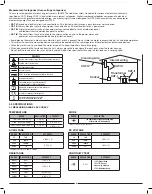
5
5.5 RESISTANCE
When measuring resistance always make sure the power to the circuit is off.
1. Insert the black (negative) test lead into the
COM input terminal.
2. Insert the red (positive) test lead into the
INPUT terminal.
3. Set the Slide Switch to
A
A
400A
400A
4. Press the
SELECT button until is shown on the display.
5. Touch the test leads to the resistor or non-energized component to be measured.
6. Read the value of the measurement displayed. With resistance measurements, the polarity of the test leads is not a factor.
7. Typical resistance measurements include resistors, potentiometers, switches, extension cords and fuses.
Note: For measurements > 1M
Ω
, the meter may take a few seconds to stabilize reading. This is normal for high
resistance measurements. When the input is not connected, i.e. at open circuit, “ OL” will be displayed as an overrange indication.
5.6 CONTINUITY
To avoid damages to the Meter or to the devices under test, disconnect circuit power and discharge all
the high-voltage capacitors before measuring resistance.
Do not input 60V DC or 30V AC to avoid personal harm. Do not use on energized circuits.
1. Insert the black (negative) test lead into the
COM input terminal.
2. Insert the red (positive) test lead into the
INPUT terminal.
3. Set the Slide Switch to
A
A
400A
400A
4. Press the
SELECT button until
is shown on the display.
5. Connect the test leads across with the object being measured.
6. The buzzer sounds continuously if the resistance of a circuit under test is <~10
Ω
. It indicates the circuit connection is good.
7. The buzzer does not sound if the resistance of a circuit under test is >70
Ω
. It indicates a possible broken circuit.
8. The buzzer may or may not sound if the resistance of a circuit under test is 10
Ω
-70
Ω
.
9. Read the resistance value on the display.
10. Typical continuity measurements include switches, extension cords and fuses.
Note: Open circuit voltage is around 2V. When the input is not connected, i.e. at open circuit,
“ OL” will be displayed as an overrange indication.
5.7 BATTERY 1.5V
1. Insert the black (negative) test lead into the
COM input terminal.
2. Insert the red (positive) test lead into the
INPUT terminal.
3. Set the Slide Switch to 1.5V
4. Touch the black (common) test lead to the negative (
-) terminal
on the 1.5V battery and the red test lead to the positive (
+) terminal on the 1.5V battery.
5. Read the value of the measurement displayed. If the leads are reversed a “
-“ indicator will appear on the display.
6.0 BATTERY REPLACEMENT
To avoid false readings, which could lead to possible electric shock or personal injury,
replace the battery as soon as the battery indicator
appears.
1. Disconnect the connection between the test leads and the circuit under test, and remove the
test leads from the input terminals of the meter.
2. Turn the Meter power off.
4. Remove the screw from the battery cover on the back of the meter. Slide the battery cover off.
5. Replace the old batteries with 2 fresh AAA batteries.
Note: Do not use rechargeable batteries in this unit.
6. Carefully slide on the battery cover and tighten the screw.
Do not overtighten the screw as this may strip the threads in the meter housing.
8.0 GENERAL SERVICE
• Periodically wipe the case with a damp cloth and mild detergent. Do not use abrasives or solvents.
• To clean the terminals use a cotton swab and detergent, as dirt and moisture in the terminals can affect readings.
• Turn the Meter power off when it is not in use.
• Take out the battery when it is not used for a long time.
• Do not use or store the Meter in a place of humidity, high temperature.
























